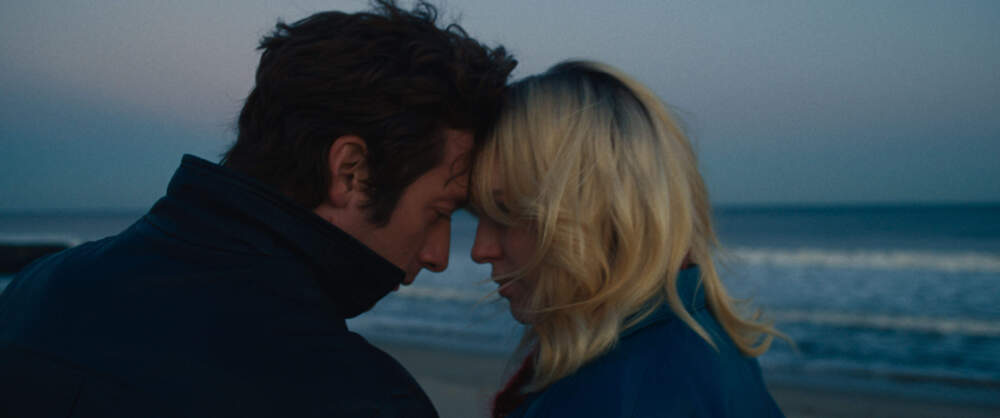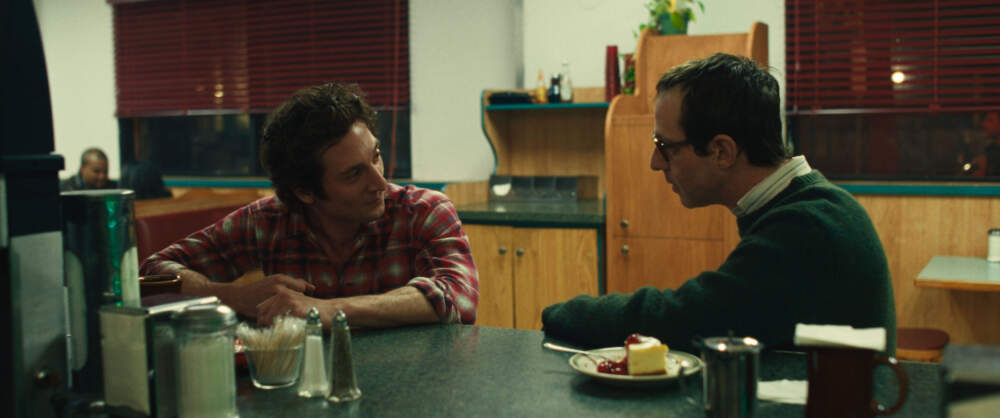“Chalamet’s looking pretty good right now, huh?” a musician pal said as we staggered in a daze out of “Springsteen: Deliver Me from Nowhere.” Writer-director Scott Cooper’s moribund portrait of The Boss is as enervating a movie experience as you’ll have this year, a tedious emotional flatline about a dark chapter in the singer’s personal history that plays like a song with only one note. The movie is cartoonishly reductive and crassly fictionalized in the manner of most formula Hollywood biopics, yet stubbornly absent any of the genre’s cheeseball satisfactions. It wears its starchy joylessness as a point of pride, drowning in a dour self-importance that reflects poorly on both the filmmakers and their subject. As soon as the lights came up, another friend who has been going to Bruce shows since 1988 turned to me and said, “I don’t think I like Bruce Springsteen anymore.”
Adapted from a terrific 2023 book by Boston rock royalty Warren Zanes, “Deliver Me from Nowhere” starts in 1981, with Springsteen and the E Street Band wrapping up their world tour promoting “The River” — a legendary stretch during which concerts frequently pushed the four-hour mark because the singer was so depressed he couldn’t bear to face his life offstage. In the deafeningly quiet aftermath of his greatest commercial success so far, Springsteen rattled around an ugly, empty rental house in Colts Neck, New Jersey, recording haunted murder ballads on a primitive four-track cassette recorder and contemplating killing himself.
The album that came out of this long, dark night of the soul, 1982’s “Nebraska,” is an eerie, unsettling masterpiece. A tour de force of sparse, evocative short stories and no frills, lo-fi production, it’s the Springsteen record that’s revered even by people who aren’t into the whole Bruce thing, forsaking the songwriter’s usual soaring anthems and catchy hooks for a stark stare into the abyss. It was never intended to be released. Springsteen laid down the tracks as demos he assumed he’d rerecord later with the band. But there was something about these warbly, echoey murmurings he couldn’t shake, an authenticity that couldn’t be replicated in the studio. Eventually, he and manager Jon Landau convinced an understandably reluctant Columbia Records to release the original demos as they were, save for one outtake they kept for future use: a little ditty called “Born in the U.S.A.”
Zanes’ book expertly traces the swirl of influences that resulted in “Nebraska.” At the time, Springsteen was obsessively listening and relistening to underground alt-rockers Suicide’s “Frankie Teardrop” — a 10-and-a-half-minute aural assault about a man who shoots his wife and infant child — while reading Flannery O’Connor and watching “The Night of the Hunter” and Terrence Malick’s “Badlands.” He became fixated on the late-1950s Charles Starkweather murder spree that inspired both Malick’s film and the title track of “Nebraska,” which I’ve always assumed would have been called “Badlands” if Springsteen hadn’t already written a song called “Badlands” a few years earlier.
This is all fascinating stuff to read, especially with the benefit of Zanes’ sharp cultural expertise. However, none of it is in the slightest bit cinematic. The film version strands us with endless scenes of Bruce — played by Jeremy Allen White, giving the exact same meekly tortured hunk performance he gives on TV’s “The Bear” — lying around, being sad and watching television. At one point, he sits up and gives an “aha” look when he sees Martin Sheen shoot Warren Oates in “Badlands,” but my favorite might be when he very dramatically picks up a Flannery O’Connor book, silently reads maybe two sentences at most, then puts it down and stares soulfully into space. I had to stifle a giggle soon after, when Springsteen is seen in a library researching the Starkweather murders on a microfiche machine, slowly writing “WHY?” in his notebook.

The songs from “Nebraska,” with all their suggestive mysteries and complexity, are reduced to the dumbest, most boringly obvious interpretations imaginable by director Cooper, who mires everything in black-and-white flashbacks to an 8-year-old Bruce being terrified of his abusive, mentally ill father. “Mansion on the Hill” is accompanied by shots of — you guessed it — Bruce and his dad in front of a literal mansion on a literal hill. The movie has no interest in the sophisticated narratives of these compositions, leaving an uninitiated viewer to assume the songs are exclusively about his daddy issues. (“Nebraska” is full of strong stories unrelated to the singer’s family history. Sean Penn’s excellent 1991 directorial debut “The Indian Runner” was a feature-length adaptation of the album’s “Highway Patrolman.”) What passes for the emotional climax of the film also seems to imply that “My Father’s House” was the first time Springsteen sat down and wrote about his dad, as if previous records weren’t full of tunes like “Adam Raised a Cain” and “Independence Day.”
The movie has a weird way of treating the singer as a frightened baby bird on the precipice of stardom, instead of someone who had simultaneously been on the covers of TIME magazine and Newsweek some seven years earlier. The recording studio scenes are a complete washout, discussing instead of dramatizing the ongoing failure to recreate the “Nebraska” sound Springsteen was looking for. This is a man who famously spent a full six weeks trying to get the drum sounds right when recording “Born to Run,” yet the film acts as if his fussiness were some sort of new development. And forget about the E Street Band. Here, they’re just the hired help, without a single line of dialogue among them in the entire film. (I still can’t believe someone made a Bruce Springsteen movie in which Clarence Clemons and Steve Van Zandt don’t get to talk.)

Instead of any band dynamics, we spend an enormous amount of screen time on a fictional girlfriend invented just for the film. Odessa Young plays a sexy blonde single mom who hangs out at Springsteen’s favorite Asbury Park rock club and has a hackneyed romance with the emotionally unavailable singer. There’s no reason whatsoever for her to exist in the story, except as a walking studio note ordering them to add a romance angle and make sure everyone knows Bruce Springsteen isn’t gay. It completely undercuts the whole “Nebraska” legend of a tortured man at the end of his rope scrawling out these songs in a cry of despair and isolation if he’s going to keep pausing to take his hot girlfriend and her adorable daughter out for fun afternoons on the boardwalk.
Telling this story with any integrity would probably have resulted in something like Gus Van Sant’s “Last Days,” which followed a suicidal rock star wandering an enormous, empty house to harrowing, avant-garde ends. But you can’t get away with that in a PG-13, inspirational Oscar-bait biopic produced by Disney that happens to be coming out on the same day as Springsteen’s second super-expensive box set of outtakes in the past five months. (The fabled, full-band “Electric Nebraska” tracks, which in the movie Bruce says make him sick to his stomach, can soon be yours for only $80.) It’s bitterly ironic that a movie about the most artistically uncompromising record ever released by a major label star feels so… well, compromised.
As Springsteen’s ever-stalwart manager, Jeremy Strong gives one of his characteristically compelling weirdo performances. Landau was a renowned rock critic before he went to work for The Boss, which might be why he’s always delivering long-winded elucidations of Springsteen’s songs, spending epic, unintentionally amusing scenes mansplaining Bruce to his wife. What a thankless role for the gifted Grace Gummer. The fact that they got Meryl Streep’s daughter to play a part that requires her only to nod approvingly at her husband is both telling and kind of hilarious, but one mainly leaves the movie feeling tremendous sympathy for anyone who had to be married to Jon Landau.

After four seasons of “The Bear,” Jeremy Allen White strikes me as an attractive young actor in desperate need of finding a few new gears. The problem with making movies about musical icons is that the actors are never as captivating as the performers they’re portraying. Whether you’re as studious as Timothee Chalamet or ridiculous as Rami Malek, it’s an impossible task. Even someone as magnetic as Austin Butler in “Elvis” was no Elvis Presley. (The one exception to this is Val Kilmer in “The Doors.” When you watch old footage of the real Jim Morrison, you’re kind of disappointed that he wasn’t as cool as Val Kilmer.)
I’ve seen Bruce Springsteen in concert 27 times, and even people who can’t stand the guy’s music will admit that onstage he’s a generational talent. “Deliver Me from Nowhere” deliberately skimps on too much performance footage because it’s an unfair ask of any actor, with White straining to pantomime those trademark, contorted Bruce faces like a raspy-voiced bobblehead for a couple of sweaty, shockingly thin-sounding numbers. The thundercrack of Max Weinberg’s snare drum on “Born in the U.S.A.” — maybe the most iconic snare hit in rock ‘n’ roll history — is tinny and pathetic here. Nobody spent six weeks getting the drum sounds right on this movie, that’s for sure.
“Springsteen: Deliver Me from Nowhere” is now in theaters.
First Appeared on
Source link













